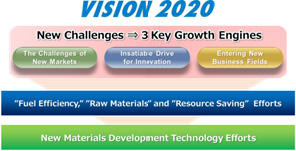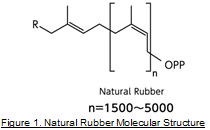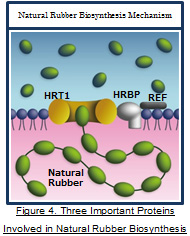| *1: | Graduate school of Engineering,Tohoku University, Professor Toru Nakayama, Associate Professor Seiji Takahashi and Assistant Professor Satoshi Yamashita (Now an Associate Professor at Kanazawa University) | |
| *2: | The IRC is an annual conference that brings together researchers in the rubber and elastomer field from around the world with the aim of promoting the international exchange of ideas as the first step toward furthering scientific progress and technological development. | |
Having established VISION 2020, our long-term vision laying out what the Sumitomo Rubber Group hopes to accomplish by the year 2020, we have been taking on various New Challenges toward the achievement of our goals, driven by the three key Growth Engines that we defined in VISION 2020: the "Challenges of New Markets," an "Insatiable Drive for Innovation" and "Entering New Business Fields." As part of our "Insatiable Drive for Innovation," we have been actively engaged in new product development that aims to answer the question: "What can tires contribute to the global environment?" with a focus on three key areas of environmentally friendly product development-Fuel Efficiency, Raw Materials and Resource Savings. The results of this recent research are among the many fruits brought about through our ongoing efforts in terms of new materials development technology.
|  | |
Long used in tires and various other rubber products, natural rubber is a type of polymer that is primarily produced through biosynthesis in Para rubber trees, which can be cultivated in tropical regions. Although it has long been known that the structural framework of natural rubber is a cis-1,4-polyisoprene structure (Figure 1), the mechanisms behind the biosynthesis of natural rubber have remained shrouded in mystery until now. In addition, while there have been several reports on the existence of proteins that play a role in the biosynthesis of natural rubber, the exact functions of these proteins have not been directly verified through previous research. In this study, we developed a protein assay system to reconstitute natural rubber biosynthesis mechanisms in vitro.
|  | |
Through joint research conducted in cooperation with Tohoku University with the aim of developing new techniques for evaluating the functions of proteins in the biosynthesis of rubber, we have successfully developed a method of determining the functions of various types of protein bound to the surface of rubber particles (Figures 2, 3). Thanks to this breakthrough technique, we have found that there are three different types of protein that play a crucial role in the biosynthesis of rubber: "Hevea rubber transferase 1 (HRT1)," "Rubber elongation factor (REF)"and"HRT1-REF bridging protein (HRBP)" (Figure 4).
| |
|  |
|
 | | |
| HRT1 | : | Hevea Rubber Transferase 1 |
|
| HRBP | : | HRT1-REF Bridging Protein |
|
| REF | : | Protein Known as "Rubber Elongation Factor" |
|
|
|
| |
|
Through various testing and analysis, our results have revealed the functions of each of these types of protein: "HRT1" is a protein that catalyzes rubber polymerization, "HRBP" is a protein that facilitates bonding between "HRT1" and the membrane where natural rubber accumulates during the biosynthesis process and "REF" is a protein that plays a role in stabilizing the membrane.
By building upon this discovery to further elucidate the mechanisms behind the biosynthesis of natural rubber, we can anticipate significant progress in the development of new technologies to ensure a more stable supply of natural rubber.
|